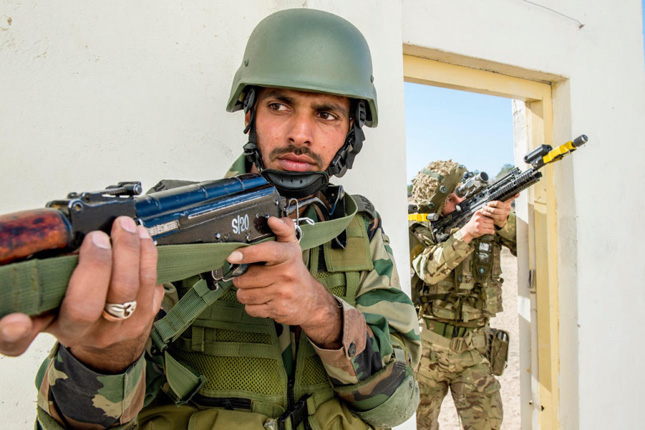-
Indian Military Recognizes Environment as “Critical” Security Issue, But Response Is Still Fragmented
January 29, 2018 By Dhanasree Jayaram
For the first time, the Joint Doctrine of the Indian Armed Forces acknowledges that the “environment has emerged as a critical area of the security paradigm,” and warns that if environmental degradation and related issues increase security risks, the military will need to respond. Released in 2017, the doctrine lists a series of non-traditional security challenges linked to the environment that could influence conflict and war, including “climate change, ecosystem disruption, energy issues, population issues, food-related problems, economic issues of unsustainable modes of production, and civil strife related to environment.” While the military has taken steps to address its impacts on the environment, it can do much more to support the nation’s environmental goals and mitigate environment-related security risks.
Why Is the Indian Military Concerned About Environmental Security?
The Indian military has recently begun to look more closely at the impact of environmental change on its tactics, operations, and strategy. This change in approach was triggered by the devastation wrought by the 2004 Indian Ocean tsunami on the Car Nicobar Air Force Base, and by more recent events, including 2014’s Cyclone Hudhud, which wrecked the air base at India’s Eastern Naval Command. Damage from the cyclone, which cost the Indian Navy more than US$300 million, demonstrates the threat posed by increasingly intense and frequent storms and sea-level rise to India’s naval assets on its eastern coast.
Looking forward, the military will need to adjust its equipment and its strategies to cope with the impacts of environmental changes. For example, to sustain their operational capabilities, temperature-controlled equipment (including tanks, submarines and aircraft), it will have to adapt to changing climatic conditions, as well as meet the requirements of Ozone Depleting Substances regulations.
Environmental change could physically alter the battlefieldEnvironmental change could physically alter the battlefield, forcing India’s armed forces to change their existing game plans. Indian troops are deployed in some of the country’s most ecologically and politically sensitive zones, such as its mountainous border with Pakistan, where enemy forces could exploit an environmental disaster to strike critical nodes and vulnerabilities. For example, changes in Himalayan glaciers could cause the water levels in downstream rivers to fluctuate drastically, limiting the military’s range and endangering water supplies for military installations.
Climate change may also spur people in vulnerable countries to cross borders in search of safer ground. India has fenced part of its border with Bangladesh to prevent illegal immigration, and while most of these migrants are not yet pushed by climatic changes, some experts imagine an alarming scenario where climate change-induced migration lead the two countries to wage war with each other. Even in the absence of climate migration, Indian armed forces have to take environmental factors into consideration while patrolling and safeguarding the border.
The Indian Military’s Environmental Efforts
Across the country, the Indian military is taking some steps to improve its sustainability and efficiency. For example, it is helping increase the country’s renewable energy generation capacity by allowing defense lands to host solar energy installations. Similarly, the Indian Navy recently launched its first warship running entirely on biofuel at the 2016 International Fleet Review and it is in the process of upgrading its blue-water capabilities to achieve a zero carbon footprint. Karwar – which is not only India’s largest naval base, but also the largest naval base east of the Suez Canal – has been designed to be a “Smart Green Naval Base” with highly efficient energy, water, and wastewater management systems.
Another priority area for the Indian armed forces is military-to-military cooperation around humanitarian assistance and disaster response. The military has been working with the United States, Japan and other countries to conduct joint exercises in the region. Since the 2004 Indian Ocean tsunami, the Indian armed forces have been at the forefront of regional disaster response, offering assistance to the country’s immediate neighbors and beyond, most notably the response to Typhoon Haiyan in the Philippines.
The Coldest War—And the Biggest Battle
On the world’s highest battleground, Indian and Pakistani soldiers face off on the rapidly melting Siachen glacier, which has receded by nearly 800 meters during the last 20 years. Some experts assert that the heavy military presence in the region has helped to accelerate the melting and polluted the Indus River that flows through both countries. To mitigate their impact on the glacier, the Indian Army launched the Clean Siachen-Green Siachen Campaign to plant trees on the Indian side of the border. However, to maintain its operations in the region, and staunch the criticism they face, the military must also deal with the human waste that has polluted the river—and prepare for the long-term impacts of climate change on this ongoing conflict.
Until now, the Indian military has taken only fragmented and sporadic steps to address environmental security risks. But going forward, it should align its efforts with the country’s environmental objectives, especially the government’s National Mission for a Green India. Not only should the armed forces adhere to the norms of environmental accountability, by taking a more holistic and institutionalized approach, they could also deploy their resources to help achieve long-term national security objectives that are imperilled by environmental degradation.
Disclaimer: The views expressed in this article are personal.
Dhanasree Jayaram is Project Associate, Manipal Advanced Research Group (MARG), Manipal University, Karnataka, India.
Sources: The Economic Times; The Hindu; The Hindustan Times; India Today; Indian Defense News; The Indian Ministry of Defense; The Indian Ministry of Environment, Forest and Climate Change; The National University of Singapore; NDTV; Rediff India Abroad; The Sunday Guardian; The Times of India; Zee News
Photo Credit: India-UK third joint military training exercise in Rajasthan, January 2018, courtesy of the British High Commision, New Delhi
 A Publication of the Stimson Center.
A Publication of the Stimson Center.



